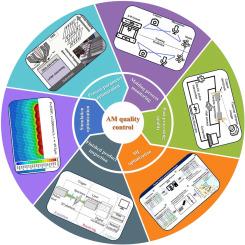Machine learning assisted quality control in metal additive manufacturing: a review
引用次数: 0
Abstract
Additive manufacturing (AM) promotes the production of metallic parts with significant design flexibility, yet its use in critical applications is hindered by challenges in ensuring consistent quality and performance. Process variability often leads to defects, insufficient geometric accuracy and inadequate material properties, which are difficult to effectively manage due to limitations of traditional quality control methods in modeling high-dimensional nonlinear relationships and enabling adaptive control. Machine learning (ML) offers a transformative approach to model intricate process-structure-property relationships by leveraging the rich data environment of AM. The study presents a comprehensive examination of ML-driven quality assurance implementations in metallic AM. First, it uniquely examines the innovative exploration of ML in predicting and understanding the fundamental multi-physics fields that influence the quality of a fabricated component, including temperature fields, fluid dynamics and stress/strain evolution. Subsequently, the application of ML in optimizing key quality attributes, including defect detection and mitigation (porosity, cracks, etc.), geometric fidelity enhancement (dimensional accuracy, surface roughness, etc.) and material property tailoring (mechanical strength, fatigue life, corrosion resistance, etc.), are discussed in detail. Finally, the development of ML-driven real-time closed-loop control systems for intelligent quality assurance, the strategies for addressing the data scarcity and cross-scenario transferability in metal AM are discussed. This article provides a novel perspective on the profound potential of ML technology for metal AM quality control applications, highlights the challenges faced during research, and outlines future development directions.

机器学习辅助金属增材制造质量控制综述
增材制造(AM)促进了具有显著设计灵活性的金属零件的生产,但在确保一致的质量和性能方面的挑战阻碍了其在关键应用中的使用。由于传统的质量控制方法在高维非线性关系建模和自适应控制方面的局限性,工艺变异性往往会导致缺陷、几何精度不足和材料特性不充分,难以有效管理。机器学习(ML)提供了一种变革性的方法,通过利用AM的丰富数据环境来建模复杂的过程-结构-属性关系。该研究提出了一个全面的检查机器学习驱动的质量保证实现在金属增材制造。首先,它独特地研究了机器学习在预测和理解影响制造组件质量的基本多物理场方面的创新探索,包括温度场、流体动力学和应力/应变演化。随后,详细讨论了机器学习在优化关键质量属性中的应用,包括缺陷检测和缓解(气孔、裂纹等)、几何保真度增强(尺寸精度、表面粗糙度等)和材料性能裁剪(机械强度、疲劳寿命、耐腐蚀性等)。最后,讨论了用于智能质量保证的机器学习驱动的实时闭环控制系统的开发,以及解决金属增材制造中数据稀缺性和跨场景可移植性的策略。本文从新的角度阐述了机器学习技术在金属增材制造质量控制应用中的巨大潜力,强调了研究过程中面临的挑战,并概述了未来的发展方向。
本文章由计算机程序翻译,如有差异,请以英文原文为准。
求助全文
约1分钟内获得全文
求助全文

 求助内容:
求助内容: 应助结果提醒方式:
应助结果提醒方式:


